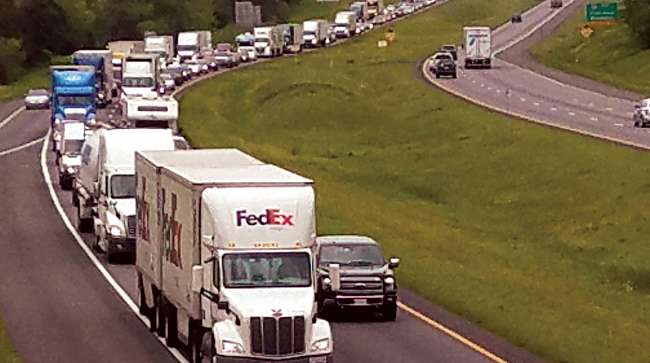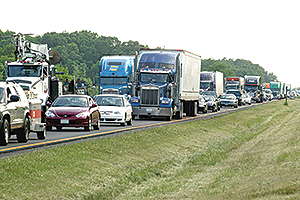Staff Reporter
Virginia Transportation Leaders Approve I-81 Improvement Plan

Virginia’s Commonwealth Transportation Board has approved a plan that weighs the possibility of tolls to address some of the issues that affect Interstate 81.
The Commonwealth Transportation Board is a 17-member group, appointed by the governor, that allocates highway funding, designates routes and funds airports, seaports and public transportation. The group worked with Virginia’s Office of Intermodal Planning and Investment and Department of Transportation to study financing methods to improve I-81, which runs through the state for 325 miles.
On Dec. 5, the board unanimously approved the I-81 Corridor Improvement Plan, which serves as a review of problem areas along the route and identifies possible solutions, including financing options.
3 i 81 Corridor Improvement by Transport Topics on Scribd
“I-81 is one of our older interstates in Virginia. I think there’s a sense that it’s 81’s time for some attention,” Ben Mannell, VDOT’s assistant director of transportation planning, told Transport Topics. “In terms of major improvements, 81 has not had that many, comparatively speaking, [as] the other interstates in Virginia.”
Chapter 743 of the 2018 Virginia Acts of Assembly directs the board to study the feasibility of high-occupancy toll lanes and tolls on trucks. Specifically, the plan calls for designating certain segments of I-81 for improvement and studying truck patterns along the route. The plan states that any revenue collected on I-81 must be used for the route’s benefit.
I-81 is an important freight route, facilitating 42% of Virginia’s interstate truck vehicle miles traveled. More than 11 million trucks travel along the route per year, hauling $312 billion in goods.
Richard Evans, director of transportation for Valley Proteins Inc., said his company’s drivers use I-81 frequently to travel among manufacturing plants in Winchester, Harrisonburg and Tennessee. Valley Proteins converts animal byproducts, such as raw protein and fats, into feed and pet foods.
“It’s long overdue to do something with I-81 because it’s really been congested for many years now. Something has to be done,” Evans told TT. “This is a major area for distribution points.”
Valley Proteins ranks No. 90 on the Transport Topics Top 100 list of private carriers in North America.
Truckers will sometimes divert to alternative routes to dodge tolls. To avoid that issue, the plan aims to identify policies that would minimize diversion, such as the prohibition of trucks on parallel routes.
According to the plan, the hypothetical tolls would be collected at six gantries, which would be located at intersections with other interstates and state borders.
The study creators found that $4 billion is needed to improve certain issues, such as safety, congestion and road conditions. Potential toll rates spelled out in the plan suggest 15 cents per mile for trucks during the day and 7.5 cents per mile at night. Rates for cars would be lower, at 7.5 cents per mile during the day and 5 cents per mile at night.
Although Evans acknowledged the need for increased funding to help I-81, he said such toll rates would place too great an onus on trucks. He said an increase to the state’s excise tax rate (currently 20.2 cents per gallon for diesel and 16.2 cents per gallon for gasoline) would be a better option.
“There’s no free lunch. Someone’s got to pay for it,” Evans said. “We know it has to be paid for. Ideally, if they would raise the fuel taxes so that it shares the burden and certainly makes it a lot easier from an infrastructure standpoint is what we would favor.”

Traffic on I-81 in Virginia is often heavy. (Virginia Department of Transportation)
The plan also seeks to determine possible solutions to truck parking needs along I-81. Lack of available truck parking ranked No. 5 on the American Transportation Research Institute’s list of industry concerns, which was released Oct. 29.
The majority of I-81 is two lanes in each direction. A few stretches — those surrounding Bristol, Lexington and Wytheville — are three lanes in each direction.
One issue that bedevils passengers and freight haulers is crashes that take a long time to clear. Lanes are closed off, which can result in long backlogs. The plan notes that the route sees 45 crashes a year, each with clearance times greater than four hours. Evans said he was traveling along I-81 in the middle of a weekday and encountered a 40-mile backup for one incident.
“It’s not unusual to see that on this highway,” Evans said. “The interstate is getting to the point where it’s dangerous with the amount of traffic that’s on that road.”
As they crafted the plan, state government agencies held public meetings, focus groups and hearings that garnered more than 2,000 public comments.
The finalized plan will be presented to the General Assembly on or before the first day of the regular session, which begins Jan. 9.
“We’re not telling the General Assembly which funding option they should choose,” Mannell said. “We’re just presenting two potential options that could pay for the set of improvements that the board has adopted.”




